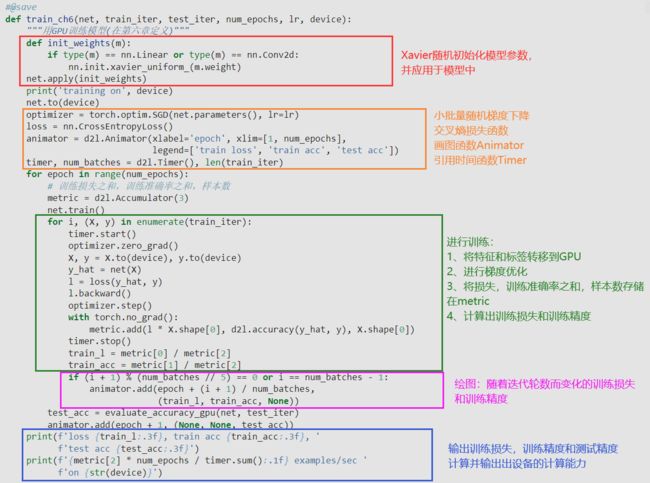动手学深度学习—深度卷积神经网络AlexNet(代码详解)
AlexNet
- 1. 学习表征
-
- 1.1 缺少的成分:数据
- 1.2 缺少的成分:硬件
- 2. AlexNet
-
- 2.1 模型设计
- 2.2 激活函数
- 2.3 容量控制和预处理
- 3. 读取数据集
- 4. 训练AlexNet
ImageNet classification with deep convolutional neural networks
原文链接:https://dl.acm.org/doi/abs/10.1145/3065386
中文翻译:https://blog.csdn.net/qq_38473254/article/details/132307508
使用深度卷积神经网络进行 ImageNet 分类
1. 学习表征
特征本身应该被学习
1.1 缺少的成分:数据
ImageNet数据集由斯坦福教授李飞飞小组的研究人员开发,利用谷歌图像搜索对每一类图像进行预筛选,并利用亚马逊众包来标注每张图片的相关类别。其有100万个样本中训练模型,以区分1000个不同类别的对象。
1.2 缺少的成分:硬件
GPU比CPU快几个数量级。
卷积神经网络中的计算瓶颈:卷积和矩阵乘法,都是可以在硬件上并行化的操作。
2. AlexNet
2.1 模型设计
2.2 激活函数
2.3 容量控制和预处理
import torch
from torch import nn
from d2l import torch as d2l
net = nn.Sequential(
# 这里使用一个11*11的更大窗口来捕捉对象。
# 同时,步幅为4,以减少输出的高度和宽度。
# 另外,输出通道的数目远大于LeNet
nn.Conv2d(1, 96, kernel_size=11, stride=4, padding=1), nn.ReLU(),
nn.MaxPool2d(kernel_size=3, stride=2),
# 减小卷积窗口,使用填充为2来使得输入与输出的高和宽一致,且增大输出通道数
nn.Conv2d(96, 256, kernel_size=5, padding=2), nn.ReLU(),
nn.MaxPool2d(kernel_size=3, stride=2),
# 使用三个连续的卷积层和较小的卷积窗口。
# 除了最后的卷积层,输出通道的数量进一步增加。
# 在前两个卷积层之后,汇聚层不用于减少输入的高度和宽度
nn.Conv2d(256, 384, kernel_size=3, padding=1), nn.ReLU(),
nn.Conv2d(384, 384, kernel_size=3, padding=1), nn.ReLU(),
nn.Conv2d(384, 256, kernel_size=3, padding=1), nn.ReLU(),
nn.MaxPool2d(kernel_size=3, stride=2),
nn.Flatten(),
# 这里,全连接层的输出数量是LeNet中的好几倍。使用dropout层来减轻过拟合
nn.Linear(6400, 4096), nn.ReLU(),
nn.Dropout(p=0.5),
nn.Linear(4096, 4096), nn.ReLU(),
nn.Dropout(p=0.5),
# 最后是输出层。由于这里使用Fashion-MNIST,所以用类别数为10,而非论文中的1000
nn.Linear(4096, 10))
# 构造一个高度和宽度都为224的单通道数据,来观察每一层输出的形状
X = torch.randn(1, 1, 224, 224)
for layer in net:
X = layer(X)
print(layer.__class__.__name__, 'output shape:\t', X.shape)
3. 读取数据集
"""
定义精度评估函数:
1、将数据集复制到显存中
2、通过调用accuracy计算数据集的精度
"""
def evaluate_accuracy_gpu(net, data_iter, device=None): #@save
# 判断net是否属于torch.nn.Module类
if isinstance(net, nn.Module):
net.eval()
# 如果不在参数选定的设备,将其传输到设备中
if not device:
device = next(iter(net.parameters())).device
# Accumulator是累加器,定义两个变量:正确预测的数量,总预测的数量。
metric = d2l.Accumulator(2)
with torch.no_grad():
for X, y in data_iter:
# 将X, y复制到设备中
if isinstance(X, list):
# BERT微调所需的(之后将介绍)
X = [x.to(device) for x in X]
else:
X = X.to(device)
y = y.to(device)
# 计算正确预测的数量,总预测的数量,并存储到metric中
metric.add(d2l.accuracy(net(X), y), y.numel())
return metric[0] / metric[1]
"""
定义GPU训练函数:
1、为了使用gpu,首先需要将每一小批量数据移动到指定的设备(例如GPU)上;
2、使用Xavier随机初始化模型参数;
3、使用交叉熵损失函数和小批量随机梯度下降。
"""
#@save
def train_ch6(net, train_iter, test_iter, num_epochs, lr, device):
"""用GPU训练模型(在第六章定义)"""
# 定义初始化参数,对线性层和卷积层生效
def init_weights(m):
if type(m) == nn.Linear or type(m) == nn.Conv2d:
nn.init.xavier_uniform_(m.weight)
net.apply(init_weights)
# 在设备device上进行训练
print('training on', device)
net.to(device)
# 优化器:随机梯度下降
optimizer = torch.optim.SGD(net.parameters(), lr=lr)
# 损失函数:交叉熵损失函数
loss = nn.CrossEntropyLoss()
# Animator为绘图函数
animator = d2l.Animator(xlabel='epoch', xlim=[1, num_epochs],
legend=['train loss', 'train acc', 'test acc'])
# 调用Timer函数统计时间
timer, num_batches = d2l.Timer(), len(train_iter)
for epoch in range(num_epochs):
# Accumulator(3)定义3个变量:损失值,正确预测的数量,总预测的数量
metric = d2l.Accumulator(3)
net.train()
# enumerate() 函数用于将一个可遍历的数据对象
for i, (X, y) in enumerate(train_iter):
timer.start() # 进行计时
optimizer.zero_grad() # 梯度清零
X, y = X.to(device), y.to(device) # 将特征和标签转移到device
y_hat = net(X)
l = loss(y_hat, y) # 交叉熵损失
l.backward() # 进行梯度传递返回
optimizer.step()
with torch.no_grad():
# 统计损失、预测正确数和样本数
metric.add(l * X.shape[0], d2l.accuracy(y_hat, y), X.shape[0])
timer.stop() # 计时结束
train_l = metric[0] / metric[2] # 计算损失
train_acc = metric[1] / metric[2] # 计算精度
# 进行绘图
if (i + 1) % (num_batches // 5) == 0 or i == num_batches - 1:
animator.add(epoch + (i + 1) / num_batches,
(train_l, train_acc, None))
# 测试精度
test_acc = evaluate_accuracy_gpu(net, test_iter)
animator.add(epoch + 1, (None, None, test_acc))
# 输出损失值、训练精度、测试精度
print(f'loss {train_l:.3f}, train acc {train_acc:.3f},'
f'test acc {test_acc:.3f}')
# 设备的计算能力
print(f'{metric[2] * num_epochs / timer.sum():.1f} examples/sec'
f'on {str(device)}')
4. 训练AlexNet
# 这里使用的是Fashion-MNIST数据集以节省时间
# Fashion-MNIST图像的分辨率(28×28像素)低于ImageNet图像,将它们增加到224×224
batch_size = 128
train_iter, test_iter = d2l.load_data_fashion_mnist(batch_size, resize=224)
# 训练AlexNet:使用更小的学习速率训练,这是因为网络更深更广、图像分辨率更高
lr, num_epochs = 0.01, 10
d2l.train_ch6(net, train_iter, test_iter, num_epochs, lr, d2l.try_gpu())





